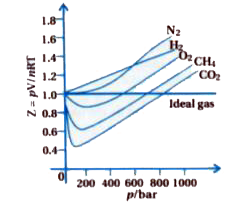Explain compressibility factor (Z). Solution in Gujrati
Compressibility factor (Z) : Deviation between real gas and idea gas is known as compressibility factor (Z).
Z=pVnRT …..(Eq. -i)
where, Z = 1
Z = Compressibility factor of ideal gas deviation behaviour,
Z=VrealVideal=real molar volumeideal molar volume .......(constant T)
For Z=1,Z>1,Z<1 is give in points (i), (ii), (iii)
(i) Z = 1 OR 1 deviation factor :
For ideal gas Z = 1 at all temperature and pressure , because pV = nRT.
If Z = 1 then gas is ideal gas and Z→p graph is parallel line.
At very low pressures all gases shown have Z = 1 and behave as an ideal gas.
Ideal gas law, follow at Z = 1 at Boyle temperature of Boyle point at real pressure.
(ii) Z>1 OR Positive deviation :
At high pressure all real gases shows Z>1 they are less compressible than ideal gas. If Z>1 than permanently gas.
N2,H2O2 shows positive deviation, Z→p graph show positive deviation.
According to diagram for H2 gas at high pressure Z>1. When pressure increases value of Z becomes more positive.
Ideal gas shows positive deviation of higher than Boyle.s point and value of a are higher than are then intermolecular attraction force are weak.
(iii) Z<1 OR negative deviation :
At intermediate pressure, most gasses have Z<1.
For O2,CH4,CO2 gas shows negative deviation, Z→p graph shows negative deviation.
According to diagram, Z<1 at lower pressure. Initially pressure increases than Z decreases, after that z cross ideal gas line.
At lower temperature then Boyle.s point value of Z decreases at increases pressure, which reacted at minimum value and pressure is continuously increases.
(iv) Graph between Z→p for some gases :

(v) Relation between Z real gas and ideal molar volume :
Z=pVrealnRT .....(Eq. -i)
If gas is an ideal,
Vreal=nRTp ......(Eq. -iii)
Value of nRTp is put in (iv) then we get equation (iii).
Z=VrealVideal ....(Eq. -v)
∴Z=Real molar volumeIdeal molar volume ......(constant T)
..Compressibility factor is ratio of real molar volume and ideal molar volume...
Topper's Solved these Questions
- STATES OF MATTER BOOK - KUMAR PRAKASHANCHAPTER - STATES OF MATTER EXERCISE - SECTION - A QUESTIONS (Sub Question)
3 Videos
- STATES OF MATTER BOOK - KUMAR PRAKASHANCHAPTER - STATES OF MATTER EXERCISE - SECTION - A QUESTIONS (TRY YOUR SELF)
47 Videos
- SOME BASIC CONCEPTS OF CHEMISTRYBOOK - KUMAR PRAKASHANCHAPTER - SOME BASIC CONCEPTS OF CHEMISTRYEXERCISE - Section - D (Solutions of NCERT Exemplar Problems) (Long Answer Type Questions)
4 Videos
- STRUCTURE OF ATOMBOOK - KUMAR PRAKASHANCHAPTER - STRUCTURE OF ATOMEXERCISE - QUESTINS PAPER FROM MODULE (SECTION -D)
2 Videos
Similar Questions
Derive Boyle.s formula according to his law.
View SolutionAt 300 K constant temperature gas having 20cm3, 1 bar pressure it is convert into 50cm3 then calculated pressure ?
View SolutionA vessel contains 1.6 g of dioxygen at STP (273.15 K, 1 atm pressure). The gas is now transferred to another vessel at constant temperature, where pressure becomes half of the original pressure. Calculate
(A) volume of the new vessel.
(B) number of molecules of dioxygen.
View SolutionExplain Heisenberg’s uncertainty principle.
View SolutionFor critical constant factor, compression factor Z is
View SolutionThe compressibility factor Z for an ideal gas will be .........
View SolutionAt Boyle's temperature , compressibility factor Z for a real gas is
View SolutionWhen the gas behvaes ideally, the compression factor Z is
View SolutionCompression factor Z is given by ________.
View SolutionDefine compressibility factor Z .
View SolutionGive the expression for
Compressibility factor (z)
View SolutionThe compressibility factor (Z) for an ideal gas is :
View SolutionWhat is compressibility factor (Z).
View SolutionExplain the significance of compressibility factor.
View SolutionThe compressibility factor Z for the gas is given by -
View Solution
